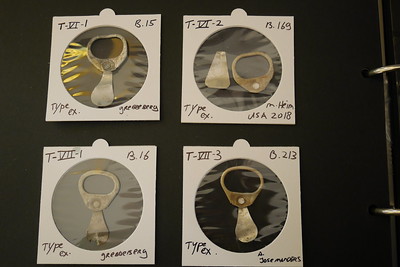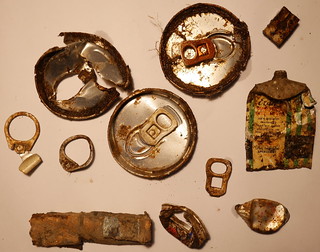
PREV ARTICLE
NEXT ARTICLE
FULL ISSUE
PREV FULL ISSUE
PULL TAB ARCHEOLOGYIn the things-other-people-collect department is this Dutch collector of pull tabs - "those humble little things that help you crack open anything from tins of fish to cans of beer". From Atlas Obscura. -Editor
In the Netherlands, where Wijnen lives and works, many archaeologists had long swooned only over things that are well and truly old, he says, and hadn’t been especially keen on newer finds. Until fairly recently, he adds, anything more recent than the medieval period wasn’t particularly alluring to old-school archaeologists. But in the past few decades, archaeologists began doubling down on their efforts to excavate World War II–era sites. "It was completely a new duck in the pond," says Wijnen. About 10 years ago he was excavating some World War II–era trenches around the Grebbeberg—a hill in Rhenen that was the site of a bloody defense against German forces—and found that the top layer of soil was littered with pull tabs. Over the next few years, he started facetiously kicking around the notion of collecting as many as he could, and seeing how they stacked up against one another. As he did, he realized that he had hit on a solid idea. "I started to realize, ‘Whoa, this is not just a joke,’" he says. "There’s much more to learn here than I would have expected." Most people have probably handled a pull tab to crack open a can of soda or soup, and would recognize the object without having looked particularly closely at it. The metal gizmos all look somewhat similar—a bit like a freshly filed fingernail—but they have scores of subtle differences that point to the time and place they were manufactured. Canned drinks really took off after the second World War, and over the next few decades, punch-top cans gave way to tabbed ones. Some pull tabs are single loops, like little rings that someone would stick a finger through; others, known as "Sta-Tabs," were designed to push a tear strip into the can to create an opening, while the tab remained on the can so it didn’t wind up on the ground. Different tabs have different perforations, different angles, and slews of other other variations. Wijnen is keen to get a handle on how different manufacturers’ styles have varied across time and place. "Two types that I know of—very early ones, called zip-tops and U-tabs—have never been produced in Europe, as far as I know," he says. 
Wijnen’s reference types are meticulously organized. Looking for something so mundane can turn out to be a little wondrous. Pull tabs are ubiquitous, but also easy to overlook—they blend into the background of the various bits of trash, debris, leaf litter freckling the ground. "It’s a silly thing that no one looks at normally," Wijnen says. "But when you do, you start seeing them everywhere." Wijnen says that before 2018, he was a bit of a lone wolf, prowling for tabs on his own, with occasional help from colleagues who would pass their finds on to him. Then, "in 2018, I said, ‘Let’s do it big time, and do it globally, and ask everyone in the world to send me the pull tabs they can find." So far, he has amassed more than 3,060 tabs. "Suddenly I get an envelope in my mailbox from Taiwan or Shanghai or Australia or Texas," he says, "and I never would have found them myself because I don’t have time or money to travel." Ideally, these donated tabs come with beautifully precise location information, down to an address where they were collected. That allows Wijnen to map them all. To read the complete article, see:
Wayne Homren, Editor The Numismatic Bibliomania Society is a non-profit organization promoting numismatic literature. See our web site at coinbooks.org. To submit items for publication in The E-Sylum, write to the Editor at this address: whomren@gmail.com To subscribe go to: https://my.binhost.com/lists/listinfo/esylum All Rights Reserved. NBS Home Page Contact the NBS webmaster 
|
